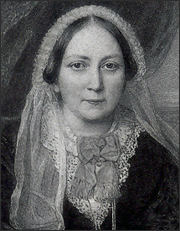Ellen Wood (author): Difference between revisions
Rescuing 1 sources and tagging 0 as dead. #IABot (v1.6.1) (Balon Greyjoy) |
|||
| Line 51: | Line 51: | ||
* ''Orville College: A Story'' (1867) |
* ''Orville College: A Story'' (1867) |
||
* ''The Ghost of the Hollow Field'' (1867) |
* ''The Ghost of the Hollow Field'' (1867) |
||
* ''Anne Hereford: A Novel'' (1868)<ref>{{cite web|url=http://www3.shropshire-cc.gov.uk/etexts/E000296.htm|title=Shropshire-cc.gov.uk|publisher=}}</ref> |
* ''Anne Hereford: A Novel'' (1868)<ref>{{cite web|url=http://www3.shropshire-cc.gov.uk/etexts/E000296.htm|title=Shropshire-cc.gov.uk|publisher=|deadurl=yes|archiveurl=https://web.archive.org/web/20071024163411/http://www3.shropshire-cc.gov.uk/etexts/E000296.htm|archivedate=24 October 2007|df=dmy-all}}</ref> |
||
* ''Castle Wafer; or, The Plain Gold Ring'' (1868) |
* ''Castle Wafer; or, The Plain Gold Ring'' (1868) |
||
* ''The Red Court Farm: A Novel'' (1868) |
* ''The Red Court Farm: A Novel'' (1868) |
||
Revision as of 12:07, 1 December 2017
Ellen Wood | |
|---|---|
 Portrait of Ellen Wood by Reginald Easton | |
| Born | Ellen Price 17 January 1814 Worcester, England |
| Died | 10 February 1887 (aged 73) England |
| Notable works | East Lynne (1861) |
| Signature | |
Ellen Wood (née Price; 17 January 1814 – 10 February 1887), was an English novelist, better known in that respect as Mrs. Henry Wood. She is remembered most for her 1861 novel East Lynne, but many of her books became international bestsellers and widely known in the United States. She surpassed the fame of Charles Dickens in Australia.[1]
Life
Ellen Price was born in Worcester in 1814. In 1836 she married Henry Wood, who worked in the banking and shipping trade in Dauphiné in the South of France, where they lived for 20 years.[2] On the failure of Wood's business, the family (including four children) returned to England and settled in Upper Norwood near London, where Ellen Wood turned to writing. This supported the family (Henry Wood died in 1866). She wrote over 30 novels, many of which (especially East Lynne) enjoyed remarkable popularity. Among the best known are Danesbury House, Oswald Cray, Mrs. Halliburton's Troubles, The Channings, Lord Oakburn's Daughters and The Shadow of Ashlydyat. Her writing tone would be described as "conservative and Christian,"[3] occasionally expressing religious rhetoric.[4]
In 1867, Wood purchased the English magazine Argosy, which had been founded by Alexander Strahan in 1865.[5] She wrote much of the magazine herself, but other contributors included Hesba Stretton, Julia Kavanagh, Christina Rossetti, Sarah Doudney and Rosa Nouchette Carey. Wood continued as its editor until her death in 1887, when her son Charles Wood took over.[6]
Wood's works were translated into many languages, including French and Russian.[7] Leo Tolstoy, in a 9 March 1872 letter to his older brother Sergei, noted that he was "reading Mrs. Wood's wonderful novel In the Maze".[8][9]
Wood wrote several works of supernatural fiction, including "The Ghost" (1862) and the often anthologized "Reality or Delusion?" (1868).[10][11]
At her death (caused by bronchitis),[12] her estate was valued at over £36,000, which was then a very considerable sum. She was buried in Highgate Cemetery, London. A monument to her was unveiled in Worcester Cathedral in 1916.
Works

These are the first published UK editions as catalogued by the British Library, with supplementary information from a specialist booksellers' catalogue.[13]
References
- ^ Dinah Birch, Katy Hooper. "The Concise Oxford Companion to English Literature". Oxford University Press. p. 783.
- ^ "The Literary Encyclopedia". "Mrs Henry Wood". Retrieved 22 December 2008.
- ^ Dinah Birch, Katy Hooper. "The Concise Oxford Companion to English Literature". Oxford University Press. p. 783.
- ^ http://oxfordindex.oup.com/view/10.1093/acprof:oso/9780199599110.003.0004
- ^ "The Ellen Wood Website". A Biographical Sketch. Retrieved 22 December 2008.
- ^ "An Index to Periodical Literature". The Argosy. Retrieved 22 December 2008.; ODNB entry: oxforddnb.com Retrieved 31 May 2011.
- ^ Harper, Kenneth E., and Bradford A. Booth (1953). "Russian Translations of Nineteenth-Century English Fiction," Nineteenth-Century Fiction, Vol. 8, No. 3, pp. 188–97.
- ^ Complete Works of Tolstoy, PSS, 61:276
- ^ Goubert, Denis (1980). "Did Tolstoy Read 'East Lynne'?," The Slavonic and East European Review, Vol. 58, No. 1, pp. 22–39.
- ^ R. A. Gilbert, Michael Cox The Oxford Book of Victorian Ghost Stories. Oxford University Press, 2003. ISBN 0-19-280447-2 (p. xvi).
- ^ J. L. Campbell Sr., "Mrs. Henry Wood", in E. F. Bleiler, ed., Supernatural Fiction Writers. New York: Scribner's, 1985. ISBN 0-68-417808-7 (pp.279-286).
- ^ "The Ellen Wood Website". Obituaries. Retrieved 22 December 2008.
- ^ Women Writers R–Z (London: Jarndyce, 2012)
- ^ "Shropshire-cc.gov.uk". Archived from the original on 24 October 2007.
{{cite web}}: Unknown parameter|deadurl=ignored (|url-status=suggested) (help)
Further reading
- Phegley, Jennifer (2005). "Domesticating the Sensation Novelist: Ellen Price Wood as Author and Editor of the 'Argosy Magazine'," Victorian Periodicals Review, Vol. XXXVIII, No. 2, pp. 180–198.
- Seecombe, Thomas (1900). "Wood, Ellen (1814-1887)," Dictionary of National Biography: Williamson-Worden, Vol. LXII, pp. 355–57.
- Sergeant, Adeline (1897). "Mrs. Henry Wood". In: Women Novelists of Queen Victoria's Reign. London: Hurst & Blackett, pp. 174–192.
- Wood, Charles W. (1887). "Mrs. Henry Wood. In Memorian," The Argosy, Vol. XLIII, pp. 251, 334, 442.
External links
- Works by Mrs. Henry Wood at Project Gutenberg
- Works by Mrs. Henry Wood at Hathi Trust
- Works by or about Ellen Wood at Internet Archive
- Works by Ellen Wood at LibriVox (public domain audiobooks)

- Mrs. Henry Wood website
- Mrs. Henry Wood at the Internet Speculative Fiction Database
- Mrs Henry Wood Bibliography Of Contributions To Periodicals
- Use dmy dates from August 2011
- 1887 deaths
- 1814 births
- Victorian novelists
- Victorian women writers
- Victorian writers
- 19th-century British novelists
- People from Worcester
- English Christians
- English women novelists
- English horror writers
- Ghost story writers
- Burials at Highgate Cemetery
- Deaths from bronchitis
- Women horror writers
- 19th-century British women writers
- 19th-century British writers
- British magazine editors